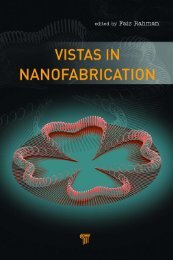Download PDF - Pan Stanford Publishing
Download PDF - Pan Stanford Publishing
Download PDF - Pan Stanford Publishing
You also want an ePaper? Increase the reach of your titles
YUMPU automatically turns print PDFs into web optimized ePapers that Google loves.
xiv<br />
Preface<br />
metals), nano-photonics (to manipulate light at a length scale below<br />
the diffraction limit), and optical microscopy (to measure the nearfield<br />
around metallic objects).<br />
Handbook of Molecular Plasmonics is intended for a broad<br />
readership and contains both high-level specialized chapters and<br />
introductory chapters as well as theoretical and experimental<br />
reviews. The main idea underlying this project is to create a useful<br />
feedback between theory and experiments, giving a theoretical<br />
reference to experimentalists and, at the same time, new inputs to<br />
theoreticians for further developments.<br />
This handbook is organized in 10 chapters that reflect the<br />
current status of this evolving scientific field, discuss the most recent<br />
developments, and identify the directions of future research.<br />
Chapter 1 introduces the basic foundations of molecular plasmonics.<br />
It is a self-contained chapter, starting with Maxwell’s<br />
equations and concluding with the derivation of the radiative<br />
and non-radiative decay rates of emitting molecules near metal<br />
surfaces and nanoparticles. After this introductory chapter, the<br />
handbook is subdivided in two parts: the first one describes the<br />
computational and theoretical methods of interest in molecular<br />
plasmonics, while the second is entirely dedicated to the most<br />
relevant applications and experimental techniques. Both parts<br />
contain precious contributions from international experts to ensure<br />
a plurality of points of view.<br />
Part I, Theory and Computational Methods, opens with a chapter<br />
by M. A. Yurkin (Russia) who describes in detail the Discrete<br />
Dipole Approximation (DDA) approach, which is an efficient method<br />
to study the absorption and scattering of metal nanoparticles of<br />
arbitrary shapes. This chapter will serve as an important reference<br />
for theoreticians to model metal nanoparticles. Chapter 3 reports<br />
DDA results for nanoparticles of different sizes and shapes. This<br />
systematic analysis, inspired by recent literature, should represent<br />
an important reference for both experimentalists and theoreticians<br />
to verify and compare the absorption and scattering spectra<br />
of different nanoparticles. While these first two chapters are<br />
completely dedicated to metal nanoparticles, Chapter 4 introduces<br />
the discussion about the molecular counterpart. In this chapter<br />
E. Fabiano (Italy) sheds light on the optical and photophysical
















